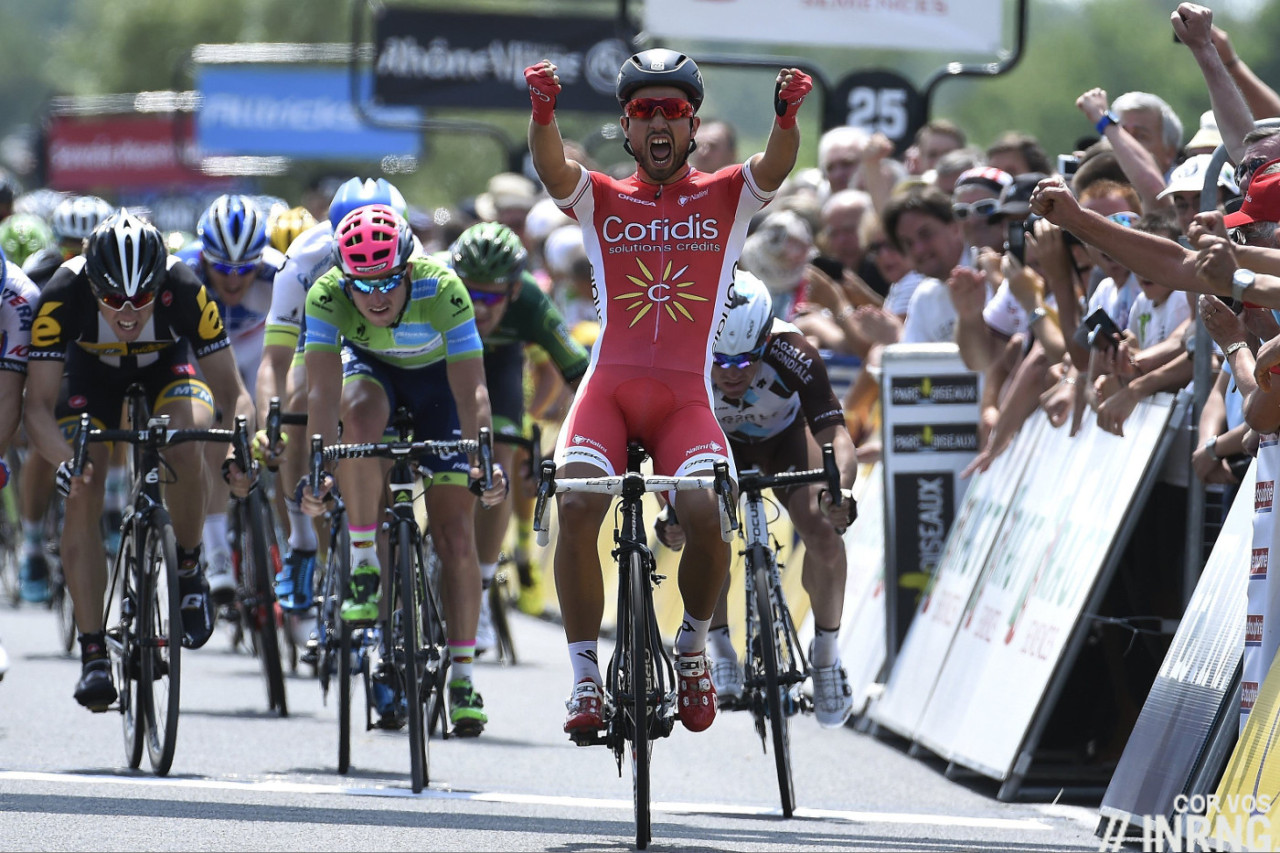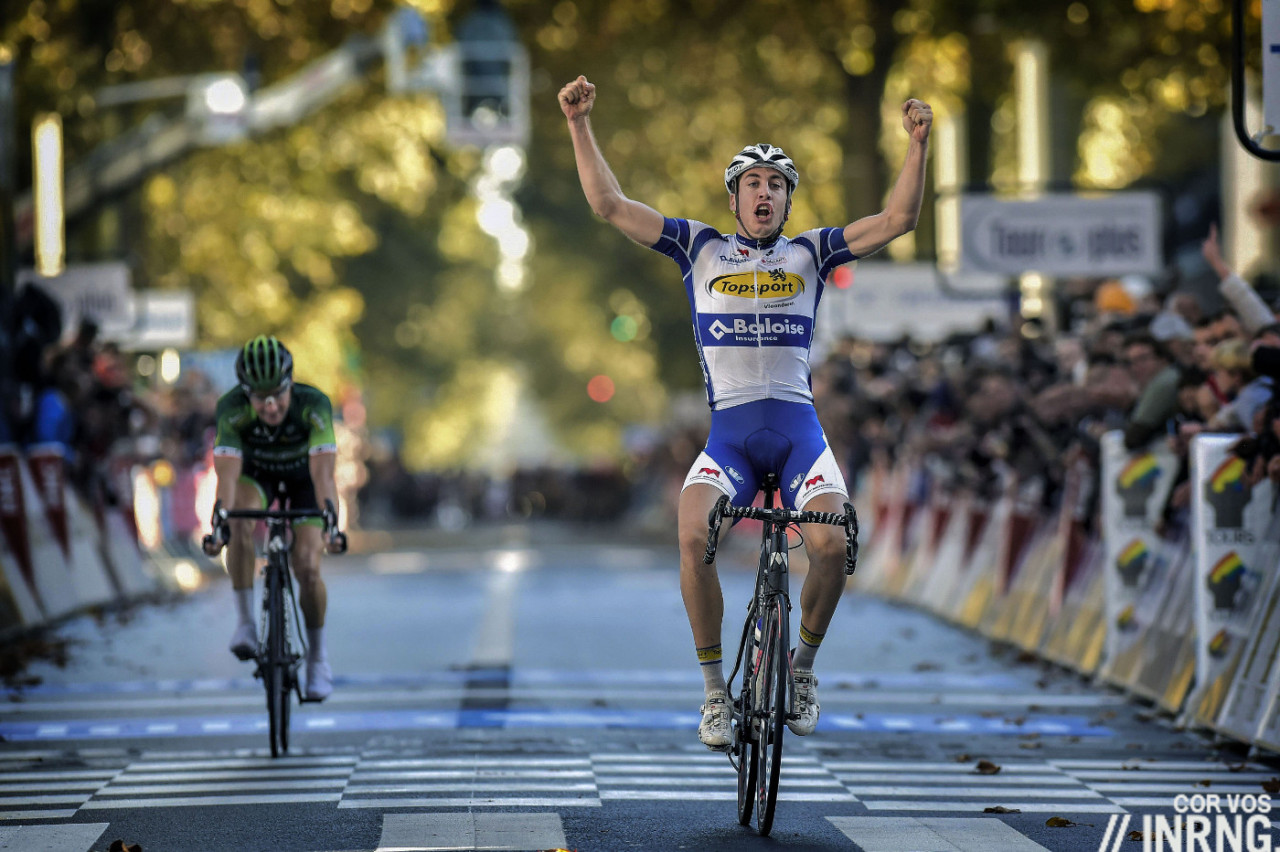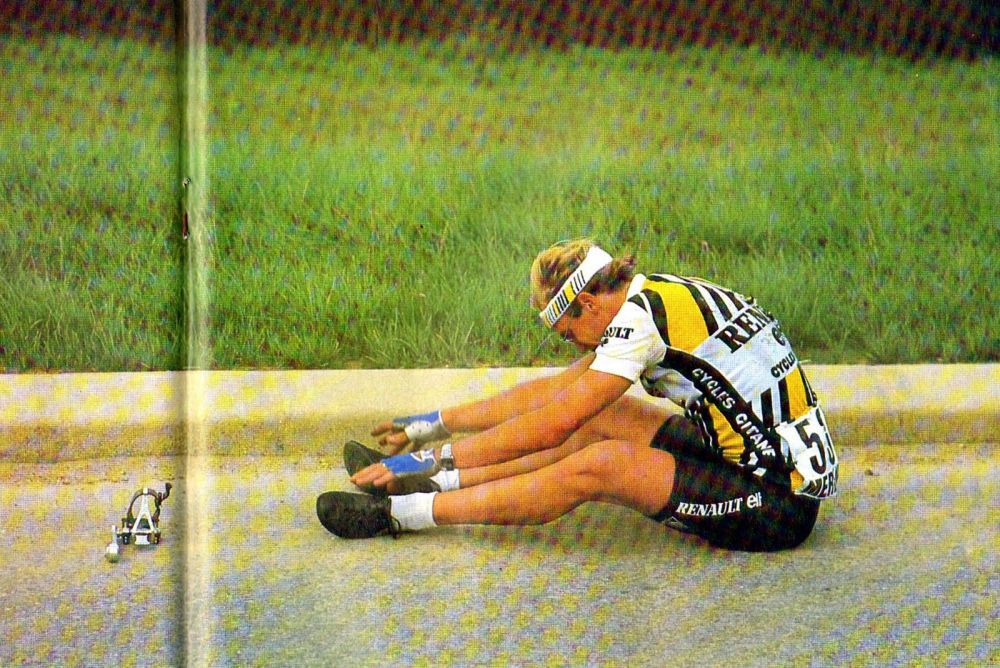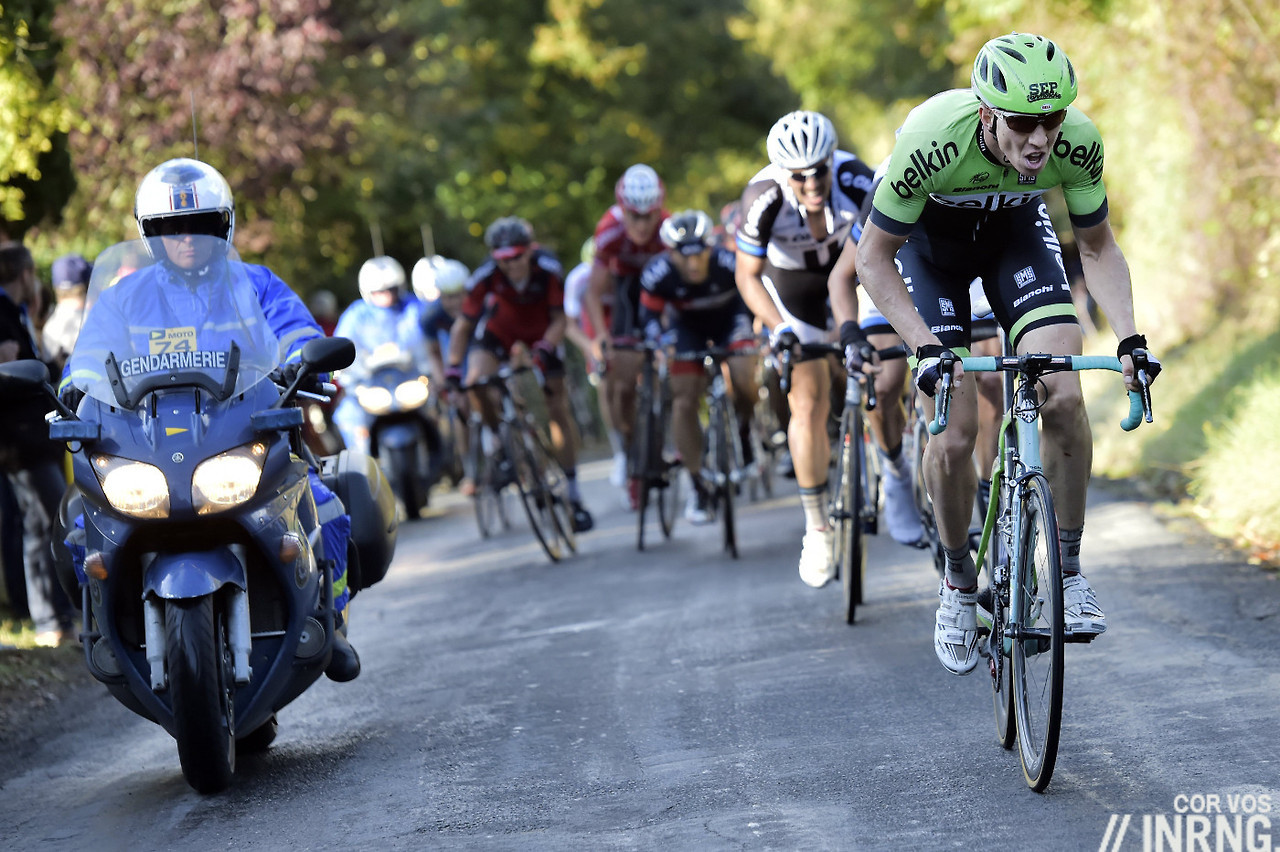Autumn’s here and with it, the last televised race of the year. Labelled “the sprinters’ classic”, this Sunday’s Paris-Tours might have a flat route but most of the winners in recent years have come from breakaways thanks to attacks launched late in the race. It’s this tension between the sprinters and breakaways that makes the race so thrilling.
Once a very prestigious race, Paris-Tours has slipped in status still provides a thrill worth watching. More so because it’s the last classic until the 2016 Omloop Het Nieuwsblad, some 140 days away.

The Route: 231km. Despite the name, Paris-Tours starts in the town of Chartres, 90km southwest Paris. The race has long started outside of capital, the départ seems to float around a lot, presumably to whoever will bid for it. Towns looking to host a stage of the Tour de France can get bonus points from ASO by welcoming this race.
As the profile shows the route is flat and a dull procession past the large fields of French agribusiness interspersed with a few glorious chateaux. This means some exposed sections.
The profile hardly shows it but are three climbs near the end of the race that, if not high, are highly strategic.
- The Côte de Crochu is 28.0km from the finish and is as close as the locals get to the Alps with its hairpins and 8% gradient although it’s taken at speed in the big ring
- Next the Côte de Beau Soleil is 10km from the finish. This is another short climb but it is distinctive for the narrowness of the road. Suddenly a giant race is funnelled into small roads and it’s not uncommon to see riders heading into the woodland as they’re squeezed off the road. But the peloton gets stretched out by the short climb and the elastic can snap, especially with the sharp turns at the top and then another narrow descent surrounded by stone walls
- Finally the Côte de l’Épan is just 7km from the finish and a final wall at 8% which has often served as a trampoline for those trying to jump away
As well as these climbs the race uses narrow roads that twist and turn and after five hours of racing riders have to keep their wits about them and fight for position.

The Finish: once upon a time the Avenue de Grammont in Tours was an endless road, the world’s longest finishing straight. But municipal meddling put a tramway in town. Nevertheless the finishing straight is 800m long, plenty of time for a big sprint. As the map above shows the race snakes its way into town and this makes it hard to control. With 5km to go things open up and note the sharp turn with 800m to go.
The Scenario: an early breakaway should go and it’s often packed with the desperate who are still hunting a contract. Several teams have an interest to set up a sprint so we should see any escapes controlled but with 30km to go things get open as the twisty route and sharp climbs encourage attacks and there’s a delicate balance between using your team to control the early break and saving riders for the tricky finale.
Fortune favours the brave. Ever since the race moved to the Avenue de Grammont in Tours in 1988, famous a sprint arrival, it turns out 16 finishes have seen breakaways versus 11 bunch sprints.

The Contenders: Nacer Bouhanni is the prime pick but he’s been on a losing streak for some time with crashes and a run of podium placings so no five chainrings for him. Some of this is due to his success, in many French races Cofidis must pull all day to chase the breakaways because all the other teams are wary of Bouhanni which means the red team are cooked before the finish and he is left fending for himself and gets beaten.
If Bouhanni’s had mixed fortunes this year, former rival Arnaud Démare had a worse time, FDJ’s sprinter with just two wins, both in May. He’s had two fourth places of late so back in the thick of the action. One problem has been that he’s tried to ride two horses, aiming for the classics and also trying to be a sprinter, and it hasn’t worked out. Here the hilly finish could well allow him to pull it off.
Sam Bennett was the last to beat Bouhanni this way in Paris-Bourges on Thursday and he’s got the explosive speed for the sprint but can he stay in the mix for the sprint over the hills?

Neo-pro Alexis Gougeard has made a name for himself with powerful breakaways and his recent prologue win in the Tour de l’Eurométropole was enough to carry him to the overall win in the race, he was even attacking in yellow jersey, proof that he’s impossible to nail down. A good candidate for a breakaway along with team mate Sébastien Turgot.
Greg Van Avermaet rides and is another obvious candidate for a late breakaway. The form should be there as he was looking sharp in Richmond but hasn’t raced since.
Sep Vanmarcke has been looking stronger of late and would make a good ally in a late move, the Belgian still needs a decent win to save his season and he was active in the race last year. He’s free to attack with Lotto-Jumbo team mate Moreno Hofland as backup for the sprint.
Trek Factory Racing have some good options with Giacomo Nizzolo as the pure sprinter then Danny Van Poppel for the sprint or a late flourish and Jasper Stuyven to join the likes of Vanmarcke and Van Avermaet, in a move but also he wants to become a name that gets mentioned alongside them.
Another team with a lot of options is Lotto-Soudal. There’s Jens Debusschere for the sprint and he’s proving increasingly regular. They’ve also got Jurgen Roelandts and Tony Gallopin for the late action with Tiesj Benoot too. Continuing the classics season vibe is Etixx-Quickstep with past podium finisher Niki Terpstra fresh from his 40km raid in Binche-Chimay-Binche backed by Gianni Meersman for the sprint, he’s one of the sprinters who copes fine with the climbs.

Jelle Wallays returns, hopefully with some victory salute practice after his odd moves last year after beating Thomas Voeckler. Edward Theuns might be the safer pick because of his fast finish.
Giant-Alpecin won here in 2013 but return with a team without the winner John Degenkolb, instead Nikias Arndt is their sprinter, a less certain prospect although he was third in the Sparkassen Münsterland Giro the other day.
Bretagne-Séché bring several sprint options with Yahueni Hutarovich, Romain Feillu and Dan McLay for the sprint. “Huta” is a chunky rider who can land big wins but the hills could defeat him with neo-pro McLay the most interesting prospect, a win seems too much but a podium’s possible.
| – | |
| Nacer Bouhanni | |
| Sam Bennett, Greg Van Avermaet, Edward Theuns, Jens Debusschere | |
| Jurgen Roelandts, Arnaud Démare, Niki Terpstra, Sep Vanmarcke | |
| Gougeard, McLay, Gallopin, Meersman, Marcato |
Weather: weak sunshine and a light tailwind of 15km/h. A top temperature 17°C.
TV: there’s a live feed from 3.30pm onwards and images will be available on Eurosport and other channels. If not there’s steephill.tv and cyclingfans.com. The finish is expected between 4.45pm-5.15pm Euro time.
History: the race goes back to 1896 and it was then run from Paris-Tours and the winner Eugène Prévost clocked an impressive 31.2km for the 250km route but it was not repeated again for a few years. By 1906 the race was staged by L’Auto, then the newspaper behind the Tour de France and to this day the race is run by ASO, the Tour company. Then the race has been on and off over the years and has seen many changes:
- In the First World War it was run in reverse with the finish in Paris
- It snowed in 1921. Francis Pélissier punctured and his hands were so cold he ripped the tire off his rim with his teeth and rode on a wooden rim to win the race
- 1959 saw the addition of the first hill, the Mont des Allouettes
- In the 1970s it started in Tours and finished in Versailles outside Paris
- It later went from Blois to Chaville

- In the 1982 Blois Chaville Laurent Fignon stood up in the team meeting and asked to lead the Renault team. They laughed but later on he was leading the race solo. The team had tried experimental titanium bottom brackets but they’d all been replaced except for the Fignon’s because he’d been training away on holiday with his bike. Suddenly the axle broke and sent Fignon flying, you can see the image above
- Only in 1988 did the race revert to Tours and it used the long, straight Avenue de Grammont. But a new tram has changed things and if the race still finishes on the same avenue, the finishing straight is just 800 metres long
- Gustaf Daneels (1934, 1936, 1937), Paul Mayé (1941, 1942, 1945), Guido Reybroeck (1964, 1966, 1968) and Erik Zabel (1994, 2003, 2005) all share the record of three wins
- Marco Marcato won in 2012 and with it, took the Ruban Jaune, the “yellow ribbon” prize for the highest average speed for a classic over 200km. The prize is measured only in pride and notoriety these days, there’s no trophy, cash nor silk sash



“Sep Vanmarcke has been looking stronger of late and would make a good ally in a late move, the Dutchman still needs a decent win to save his season and he was active in the race last year.”
As much as we’d like him to be Dutch, Sep Vanmarcke is Belgian. Although he is welcome to apply for a Dutch passport if you ask most cycling fans here. 🙂
Quite right, must have been his Dutch team in mind.
140 days away is the 2016 Het Neusblad. We all know what you meant.
At least the Tour Down Under is closer!
And if you want a one day race the Cadel Classic is on again and has been upgraded to 2.HC.
First edition was a cracking little race.
In any case, look forward to Paris Tours!
Sam Bennett could be a good bet here. He showed he can handle the climbs at the worlds, finishing in a decent 40th place, alongside Nibali.
Any race that Merckx tried to win but couldn’t should have a much higher status! As noted elsewhere by many others shame its not a WT race with all the big names.
Apparently, one year he would have won it, but gifted it to a team mate.
I think Sinkeldam is on the same level as Arndt when Giant have to pick someone for the sprint.
Especially after his awesome finish at Binche.
me too mistook with Sep before wc thinking he could be a great support for terpstra! 😉
Can the flat track bully Bouhanni finally pull off a big win this season? I wouldn’t bet on him – or Démare: neither have shone this season. I’d fancy Debusschere more than those two – and he’s strong enough to feature in a late breakaway. Plenty of other candidates for that too, which probably makes a sprint win unlikely.
Hard to see why Van Avermaet didn’t ride Binche-Chimay-Binche to build his form (and wouldn’t that race be better placed on the Wednesday between Lombardia and this?). Vanmarcke didn’t look up to much in that race (it all looked so good in the early season) – either that or his tactics were just bizarre (repeatedly being dropped by breakaway companions).
I predict a Lotto-Soudal rider will win.
I know what you mean about Wallays’s youthful exuberance last year. At the same time, I say it was beautiful to see and vive la difference!
Jelle sure was a bit wobbly – one of my favourite celebrations of last year.
I think I’ll go with a Lotto rider too, I’ll say Roelandts in a break. I fancy a breakaway and I think Debuschere will wait for the sprint.
I’ll probably be totally wrong!
Campy was never the same after the titanium incident.
Shimano stepped through the door and never left.
Watch out othersteve, the rumbling sound you hear are the Campy diehards with their pitchforks and torches coming for you.
I’ll summarize the lecture:
“It’s not the best, but it’s beautiful, it’s not the lightest, but I like how it makes me feel, and if you can’t afford it, that’s because you are poor.”
Hard to decide who to respond to, you or Steppings below.
In ’84 or ’85 I bought a beautiful new Tomassini, but with Dura-Ace S.I.S., which was the real game changer though Fignon’s bottom bracket didn’t help. It was great and I rode it for quite a few years. But, Campy is in my blood; it is beautiful, the weight is a non issue now (just put less chain down your seat tube), it does feel like nothing else, and it may be expensive but it will last forever if you take care of it. And there is something to be said for owning and using a piece of quality equipment for so long that the familiarity turns it into an extension of your being.
On topic, I hope this season is just a dip in the rising success of Bouhanni. This would be a good win for him and his team.
Personally, I would not describe any current Campagnolo groupset as beautiful (with the possible exception of SR 11RS). The Eightieth Anniversary group I was very underwhelmed by; the finish and the cardboard boxes left me cold. Sorry.
The 50th Anniversary group on the otherhand, is a work of art.
I’m afraid Campagnolo and myself had a falling out when i was building a customers bike back in the late eighties and he specifically asked for the new Syncro levers on his C Record build. I must have tried every chain/sprocket/lever insert combination and it just never indexed correctly. A repair came in and the customer wanted to fit indexed gear to it. We had in stock a Shimano 105 upgrade kit, which consisted of a pair of levers, a rear mech and a freewheel. It was all fitted within 15 minutes and worked perfectly, I was stunned and have run Dura Ace ever since. The wife uses Campagnolo on all her bikes so we have some “lively” conversations at times.
I’d argue that, until very recent years, the middle-level Campagnolo had a way better value for money, too.
The old Veloce, Centaur and Chorus (note the careful exclusion of Athena and recent years’ Veloce) are, for different reasons, a better choice than most Shimano – not to speak of Sram, which had unforgivable performance troubles plus a couple of flaws which didn’t matter for the pros, but they did matter a lot for Sunday riders.
I must say that a lot may depend on international price policy by Campagnolo, I suspect in some markets they’re selling it as more expensive goods than in Italy – also note that the reverse is (was?) true for Shimano in Italy, Shimano has always been comparatively cheaper, say, in Spain than in Italy. They told me things changed when Shimano distribution was revolutioned in Italy some 3-4 years ago or so (maybe more, losing my sense of time), but I couldn’t have direct experience of it.
I think I’ll struggle to ever forgive them for changing the aesthetics of the top groups last year.
Agree on what you say G,
I have a daily driver, Carbon fiber Bianchi with Dura-Ace, and it is wonderful tool.
But on special occasions I break out the steel Gios with 80’s Super-record.
And it is sublime.
Campagnolo is either in your blood or it isn’t. If it isn’t then settle for the fact that your life and being will be forever somewhat lacking.
+1 The ergonomics, fit and feel of Campagnolo still give me pleasure that the others simply can’t match. We’ve used Campy pretty much from the start, even when receiving free parts from others. Now we’re fortunate to count them as official suppliers to CycleItalia. In response to Othersteve’s claim I’d note the US MTB boom started in 1983 providing an opening for Shimano that Vicenza failed to exploit – so in that case it’s true they “stepped in the door and never left”. But check the current price of a Campagnolo 50th Anniversary groupset (from 1983) vs Shimano 25th DuraAce groupset (from 1998) and tell me which one the marketplace values more.
Larry if I didn’t know better I would say you are just fishing for fight.
I did have a sky blue Colnago Super with a 50th Anniversary groupo, should have never let it go.
Nah, no fight here. Some would rather eat sushi while others prefer risotto, but with a name like CycleItalia I think it would highly hypocritical of us to use groupsets from some other company. The fact that I like their stuff helped, but we certainly spent more on our rental fleet when we insisted they be Campagnolo-equipped vs competitors (one of whom offers a so-called “Campagnolo Experience tour!) using groupsets supplied by Shimano or SRAM. We try to use Made-in-Italy products whenever possible, though it gets tougher every year as too many of even the Italian brands have their stuff made in Asia these days. I was very sad to pull a set of brake calipers out of a Campagnolo box the other day and see the actual parts packed inside plastic bags with “Made in Taiwan” printed on them. I wonder if Tullio would have ever considered this idea? I’d like to think not, but obviously son Valentino is OK with it.
“+1 The ergonomics, fit and feel of Campagnolo”
Ergonomics?
Used to pedal Campy for many years, I could tell ya stories, even wore the T-shirt and caps; but for the last 10 years when I put My hands on bars, the thumb shifter never feels right. Ergonomics feels absent.
I don’t get all these differences. In the past there probably was a big difference between groups but today a correctly set up Dura Ace / Red / Ultegra / Super Record or Chorus should be flawless with precise braking, shifts under load etc. It’s a credit to all manufacturers that things just work properly now.
ditto. For me it’s practically a question of which hoods feel better, as not only is the functionality basically the same all round, but I spend more time on the hoods than braking or changing gear.
I say the same thing when I jump on a Shimano or SRAM equipped bike – it just feels wrong but I get used to it soon enough and as Mr. Inrng points out, it all works pretty well these days, though I prefer to ride (and work on) Campagnolo if at all possible. As I wrote above, some prefer sushi while for others it’s risotto…and I’m grateful there’s a choice!
As to Paris-Tours at the end I was saying it’s GVA’s race to lose…but didn’t think he’d lose to what looked like a softening front tire? That was a shame.
Everything* breaks – but yeah, timing is crucial.
*except SunTour bar end friction shifters
I seem to recall that at one time (sixties/seventies?) riders in P-T had to ride a single speed gear in an attempt to get away from bunch sprints.
I don’t think it worked though!
Laurent Fignon couldn’t touch his toes? Who knew?
I don’t even know if he could see his toes after the crash